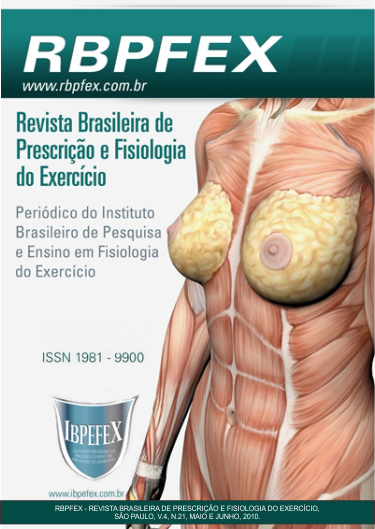Profile cardiorespiratory capacity of individuals practicing mini-trampoline by testing AHLQUIST
Abstract
Introduction: The practice of physical exercise is an excellent indicator of a good quality of life, and more and more gym classes are searched by people that are interested in keeping health. The mini trampoline isone of the new gymnastics arrangements, that has the aim to improve the cardiorespiratory system of their trainees. The objective of this research was to determinethe maximal oxygen uptake (VO2máx) by an indirect test in individuals practicing mini trampoline. Materials and methods: For the evaluation of the VO2máx was used the AHLQUISTindirect test, that was performed in a bench of 25,4 cm high for women and 30,5 cm high ,for men. N=10 people were assessed: N=2 men, 28,5 years old, 81 kg bw and 179 cm height, N=8 women, 27,8 years old, 58,2 kgbw, 153,7 cmheight, all trainees of this activity for at least a year. Results: Men had an average rate of 30 hikes in the bench during the test, a heartbeat of 152,5 bpm and had a relative VO2máx of 46,91ml/kg-1/min-1and absolute VO2máx of 3,79 l/min. However, women had an average rate of 29 hikes, heartbeat of 153,7 bpm a relative VO2máx of 41,23 ml/kg-1/min-1and absolute VO2máxof 2,38 l/min. Conclusion: People that practice mini trampoline we have evaluated had a respiratory profile separating them from the risk factors, however can not be said that the activity has influenced the values, since there was no evaluation of this profile before the start of the activity.
References
-Castinheiras Neto, A.G.; Silva, N.L.; Farinatti, P.T.V. Influência das Variáveis do Treinamento Contra-Resistência sobre o Consumo de O2 em Excesso Após Exercício: Uma Revisão Sistemática. Revista Brasileira de Medicina do Esporte, Niterói, vol. 15 ,num. 1, 2009, p. 70-78.
-Coni, P.F.C. Determinação e Comparação do VO2 máx. em Praticantes de Ciclismo Estacionário, Utilizando Nomograma de Astrand-Rhyming. Revista Brasileira de Prescrição e Fisiologia do Exercício, São Paulo. Vol. 1. Num. 4. 2007. p. 71-81.
-Furtado, E.; Simão, R.; Lemos, A. Análise do Consumo de O2, FC e Dispêndio Energético, durante as Aulas de Jump Fit. Revista Brasileira de Medicina do Esporte. Niterói. Vol. 10. Num. 5. 2004. p. 371-375.
-Kruel, L.F.M; Coertjens, M.; Tartaruga, L.A.P; Push, L.C. Validade e Fidedignidade do Consumo Máximo de Oxigênio Predito pelo Frequencímetro Polar M52. Revista Brasileira de Fisiologia do Exercício. Rio de Janeiro. Vol. 2. Num. 2. 2003. p. 147-156.
-Maranhão Neto, G.A.; Farinatti, P.T.V.; Equações de Predição da Aptidão Cardiorrespiratória sem Testes de Exercícios e sua Aplicabilidade em Estudos Epidemiológicos : Revisão Descritiva e Análise dos Estudos. Revista Brasileira de Medicina do Esporte. Niterói. Vol. 9. Num. 5. 2003. p. 304-314.
-McArdle, W.D.; Katch, F.I; Katch, V.L. Fisiologia do Exercício: Energia, Nutrição e Desempenho Humano. 6.ed.Rio de Janeiro: Guanabara Koogan, 2008.
-Nunes, R.A.M.; Pontes, G.F.R.; Dantas P.M.S.; Fernandes Filho, J. Tabela Referencial de Condicionamento Cadiorrespiratório. Fitness e Performance Journal. Rio de Janeiro. Vol. 4. Num. 1. 2005. p. 27-33.
-Santos, T.M.; Furtado, L.F.L.; Ribeiro, L.G.; Novaes, J.S. Comparação entre as Modalidades de Caminhada e Corrida da Predição do Consumo Máximo de Oxigênio. Rev. Bras. Med. Esporte. Niterói. Vol. 14. Num. 5. 2008. p. 412-415.
-Simão, R. Fisiologia e Prescrição do Exercício para Grupos Especiais. 2.ed. Rio de Janeiro: Phorte, 2007.
Authors who publish in this journal agree to the following terms:
- Authors retain the copyright and grant the journal the right of first publication, with work simultaneously licensed under the Creative Commons Attribution License BY-NC which allows the sharing of the work with acknowledgment of the authorship of the work and initial publication in this journal.
- Authors are authorized to enter into additional contracts separately for non-exclusive distribution of the version of the work published in this journal (eg, publishing in institutional repository or book chapter), with acknowledgment of authorship and initial publication in this journal.
- Authors are allowed and encouraged to post and distribute their work online (eg, in institutional repositories or on their personal page) at any point before or during the editorial process, as this can bring about productive change as well as increase impact and impact. citation of published work (See The Effect of Free Access).






